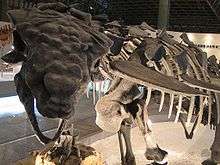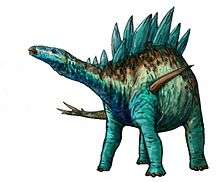Thyreophora
| Thyreophorans Temporal range: Early Jurassic-Late Cretaceous, 199.6–66 Ma | |
|---|---|
 | |
| Mounted skeleton of Mymoorapelta maysi, Makuhari Messe | |
| Scientific classification | |
| Kingdom: | Animalia |
| Phylum: | Chordata |
| Class: | Reptilia |
| Clade: | Dinosauria |
| Order: | †Ornithischia |
| Clade: | †Genasauria |
| Clade: | †Thyreophora Nopcsa, 1915 |
| Subgroups | |
| |
The Thyreophora ("shield bearers", often known simply as "armored dinosaurs" - Greek: θυρεος, a large oblong shield, like a door and φορεω, I carry) were a subgroup of the ornithischian dinosaurs. They were armored dinosaurs, living from the early Jurassic until the end of the Cretaceous.
Thyreophorans are characterized by the presence of body armor lined up in longitudinal rows along the body. Primitive forms had simple, low, keeled scutes or osteoderms, whereas more derived forms developed more elaborate structures including spikes and plates. Most thyreophorans had relatively small brains for their body size.
Thyreophorans include various subgroups, including the suborders Ankylosauria and Stegosauria. In both the suborders, the forelimbs were much shorter than the hindlimbs, particularly in stegosaurs. The clade has been defined as the group consisting of all species more closely related to Ankylosaurus than to Triceratops. Thyreophora is the sister group of Cerapoda within Genasauria.
Groups of Thyreophorans
Ankylosauria
Among the Ankylosauria, the two main groups are the ankylosaurids and nodosaurids.
Ankylosaurids are noted by the presence of a large tail club composed of distended vertebrae that have fused into a single mass. They were heavy-set and heavily armored from head to tail in bony armor, even down to minor features such as the eyelids. Spikes and nodules, often of horn, were set into the armor. The head was flat, stocky, with little or no "neck", roughly shovel-shaped and characterized by two spikes on either side of the head approximately where the ears and cheeks were. Euoplocephalus tutus is perhaps the best-known ankylosaurid.
Nodosaurids, the other family in the Ankylosauria, may actually include the ancestors of the ankylosaurids. They lived during the middle Jurassic (approx 170 mya) on up through the late Cretaceous (66 mya) and, while armored as the ankylosaurids, did not have a tail club. Instead, the bony bumps and spikes that covered the rest of their body continued out to the tail and/or were augmented with sharp spines. Two examples of nodosaurs are Sauropelta and Edmontonia, the latter most notable for its formidable forward-pointing shoulder spikes.
Stegosauria
The suborder Stegosauria comprises Stegosauridae and Huayangosauridae. These dinosaurs lived mostly from the Middle to Late Jurassic, although some fossils have been found in the Cretaceous. Stegosaurs had very small heads with simple, leaf-like teeth. Stegosaurs possessed rows of plates and/or spikes running down the dorsal midline and elongated dorsal vertebra. It has been suggested that stegosaur plates functioned in control of body temperature (thermoregulation) and/or were used as a display to identify members of a species, as well as to attract mates and intimidate rivals. Well known stegosaurs are Stegosaurus and Kentrosaurus.
Classification
Taxonomy
While ranked taxonomy has largely fallen out of favor among dinosaur paleontologists, a few 21st century publications have retained the use of ranks, though sources have differed on what its rank should be. Most have listed Thyreophora as an unranked taxon containing the traditional suborders Stegosauria and Ankylosauria, though Thyreophora is also sometimes classified as a suborder, with Ankylosauria and Stegosauria as infraorders. The following taxonomy follows Butler et al., 2011 and Thompson et al., 2011 unless otherwise noted.[1][2]
- Branch Thyreophora
- Emausaurus
- Scutellosaurus
- ?Tatisaurus
- Node Thyreophoroidea
- Family Scelidosauridae
- Node Eurypoda
- Suborder Ankylosauria
- Family Ankylosauridae
- Family Nodosauridae
- Suborder Stegosauria
- Family Huayangosauridae
- Family Stegosauridae
- Suborder Ankylosauria
Phylogeny
Thyreophora was first named by Nopcsa in 1915. Thyreophora was defined as a clade by Paul Sereno in 1998, as "all genasaurs more closely related to Ankylosaurus than to Triceratops". Thyreophoroidea was first named by Nopcsa in 1928 and defined by Sereno in 1986, as "Scelidosaurus, Ankylosaurus, their most recent common ancestor and all of its descendants". Eurypoda was first named by Sereno in 1986 and defined by him in 1998, as "Stegosaurus, Ankylosaurus, their most recent common ancestor and all of their descendants". The cladogram below follows a 2011 analysis by paleontologists Richard S. Thompson, Jolyon C. Parish, Susannah C. R. Maidment and Paul M. Barrett.[1]
| Thyreophora |
| ||||||||||||||||||||||||||||||
| |
"Tyreophorus"
"Tyreophorus" is an informal generic name, attributed to Friedrich von Huene, 1929[3] in,[4] that is sometimes seen in lists of dinosaurs. It is probably a typographical error; von Huene intended to assign indeterminate remains to Thyreophora incertae sedis, but at some point in the process of publication, the text was revised to make it appear that he was creating a new generic name "Tyreophorus" (as described by George Olshevsky in a 1999 post to the Dinosaur Mailing List).[4] The name is undescribed and has not been used seriously.
References
- 1 2 Richard S. Thompson, Jolyon C. Parish, Susannah C. R. Maidment and Paul M. Barrett (2011). "Phylogeny of the ankylosaurian dinosaurs (Ornithischia: Thyreophora)". Journal of Systematic Palaeontology. 10 (2): 301–312. doi:10.1080/14772019.2011.569091.
- ↑ Richard J. Butler, Jin Liyong, Chen Jun, Pascal Godefroit (2011). "The postcranial osteology and phylogenetic position of the small ornithischian dinosaur Changchunsaurus parvus from the Quantou Formation (Cretaceous: Aptian–Cenomanian) of Jilin Province, north-eastern China". Palaeontology. 54 (3): 667–683. doi:10.1111/j.1475-4983.2011.01046.x.
- ↑ von Huene, F. (1929). "Los Saurisquios y Ornitisquios del Cretáceo Argentino". Revista De Museo De La Plata. 3: 1–194.
- 1 2 George Olshevsky (16 Nov 1999). "Re: What are these dinosaurs". Archives of the Dinosaur Mailing List at dml.cmnh.org. The Cleveland Museum of Natural History. Retrieved 2007-01-29.

